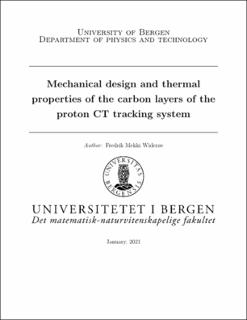Mechanical design and thermal properties of the carbon layers of the proton CT tracking system
Master thesis
Permanent lenke
https://hdl.handle.net/11250/2736243Utgivelsesdato
2021-01-15Metadata
Vis full innførselSamlinger
- Master theses [170]
Sammendrag
Cancer treatment is one of the largest and fastest growing fields in medical physics and technology. Particle therapy is considered a significant improvement for treating certain types of cancer and particle therapy facilities are being built all over the world. Several projects are developing proton computed tomography to drastically increase the treatment accuracy of particle therapy. In this thesis, we look at the mechanical support design, thermal properties and cooling systems of the tracking layers of the proton CT prototype being developed by the Bergen pCT collaboration. We have investigated which types of tools we can use for designing and modeling these, to calculate and simulate heat transfer in the tracking system and to create benchmark tests for an ideal model. This has been compared to experimental results to see how well we can expect these models to hold up compared to the real prototype. The process of designing the mechanical support and air cooling system is described in detail. We have investigated the various limitations and constraints on this system and explained the features that is implemented in the designs in light of this. The final designs provides us with a mechanical support which can be used as a stand-alone setup and a flexible air cooling system which can adapt to future changes to the pCT. The results from the calculations and simulations are consistent and give us reason to believe that the combination of water and air cooling that is planned for the pCT is sufficient for keeping the operational temperature of the tracking system low enough, although we have not considered the additional thermal resistance from mechanical contact and coupling. All of these results suggest that the maximum temperature of the carbon sheets will stay below 26 degrees Celsius, before we have considered the additional thermal resistance from mechanical contact and coupling. The experimental measurements indicates that the temperature difference given by the calculations and simulations is higher than the real system, but further conclusions would require a cooling test setup more similar to the pCT tracking system with water and air cooling.
